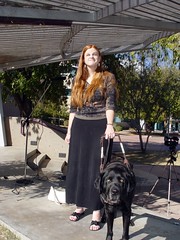Screens Everywhere
I'd like you to meet someone:
This is Sarah Outwater, a young woman who has been blind since she was 3 years old. She's a cancer survivor (metastatic retinoblastoma) and has been in her condition ever since she had surgery on her eyes to protect her from the deadly disease.
I was invited to participate in a charity project for a little girl she had heard of on the news who was in a similar condition as she was at her age, except technology has advanced and this little girl (last I heard) was free of her cancer and still able to see.
Sarah is an extremely intelligent girl and can play several different musical instruments and uses technology to support her education and professional career goals. In her charity project, she was compiling a music album and asking for donations to help the family of the girl who was receiving cancer treatments. As part of my donation, I offered to build a web site and create/donate some multimedia presentations for benefit concerts and post them on the website (This was before I heard of YouTube). Sarah brought her laptop to my workplace and we cut some video interviews together and I showed her how to edit content for the website. Later we were joking together in a group meeting about how people and technology interact. I made the quip that people who talk to their technology to get it to do obscure things are borderline bonkers, and she retorted "well that's nothing. My technology talks to me!"
Of course it was true. In our interactions for her laptop was equipped with screen reading technology that allowed her to complete her work for school and work on her music projects. This is a prime example of adaptive use of technology for a population that predominantly gets their work done despite the fact that they can't see what they are doing.
However, that's not the only way people who can't make use of their eyes to do their work continue to survive. They must be able to use their other senses. Audio alone in my humble opinion is not the savior of interaction with technology. People must be able to use their other senses too. Which of the remaining 4 senses makes the most sense for HCI for blind people? Touch or tactile surfaces is what's coming to mind.
Here is something that Macrodobia (Adobe the company and Macromedia's Technology) have been pushing for a while…the idea that consistent technology for authoring multimedia content be available on a multitude of devices. What this means is that soon someday we will be seeing flash on tons of personal handheld devices.
I also suspect we will see flash interfaces on other devices too such as kitchen appliances and home entertainment center components. Even more sobering would be to see it in public facilities and transportation devices such as elevators.
Adobe is really pushing their flash platform which is really good for people like me who enjoy learning about their platform. What I would really like to see is an concerted effort to research what accessibility options exist for persons who can't use their eyes to interact with interfaces that will potentially be flat and non-tactile.
Even Apple's iPhone with all its glitz and glory has its issues. How does a person who can't see be excited about an iPhone for their communication needs? Sarah had no problem using her cell phone to communicate, and could very easily find the buttons to push because she could feel them with her fingers. Voice activation is probably on the horizon and may become mandatory for devices using these interfaces, and I will be waiting to see what advances are on their way with Adobe's technology.

